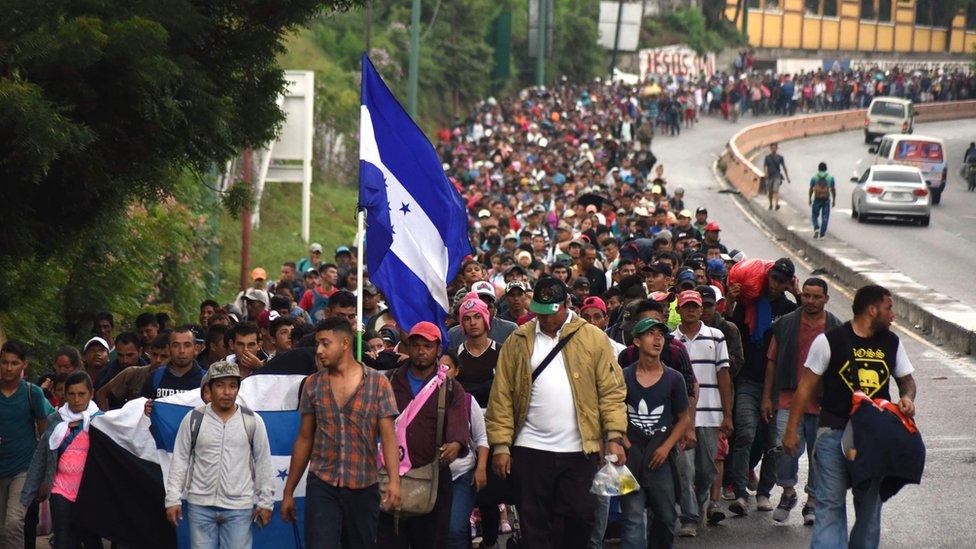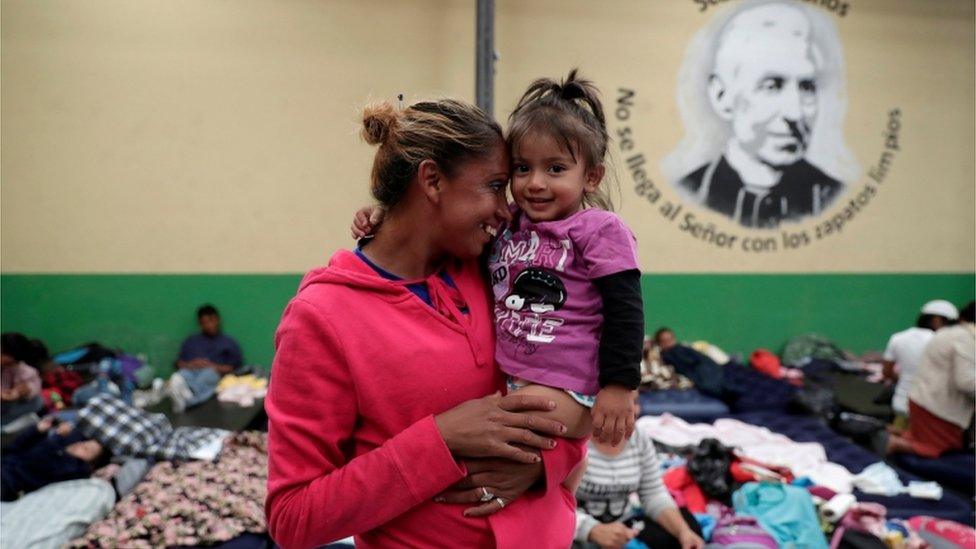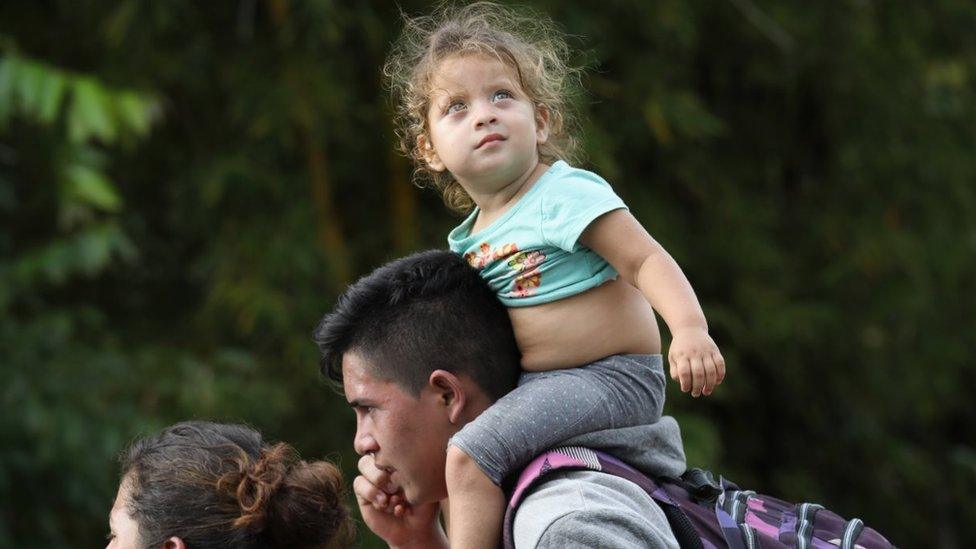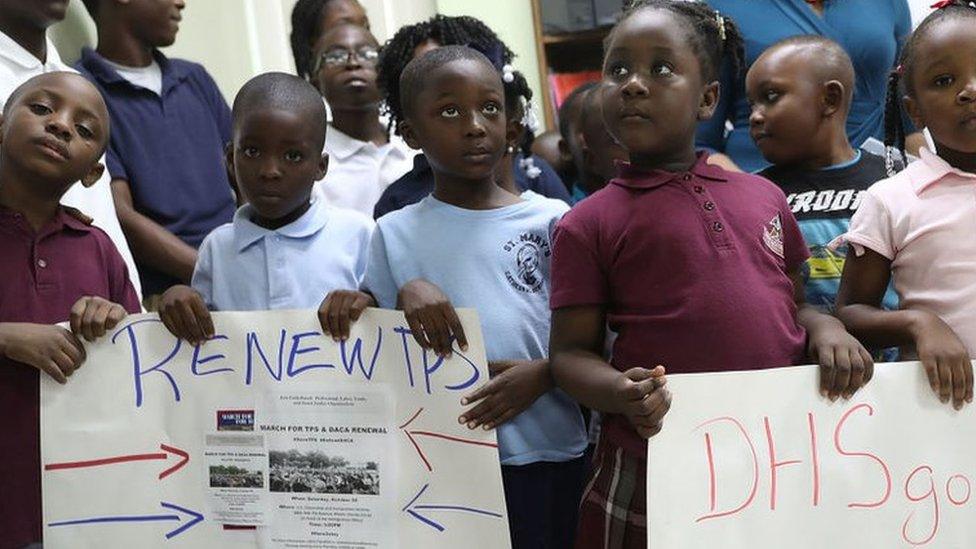Migrant caravan: Mexico sends police to southern border
- Published

The caravan set off from northern Honduras last week
Mexico has sent hundreds of police to its southern border as a caravan of thousands of Central American migrants approaches from Guatemala.
The move came after President Donald Trump threatened to use military force to completely close the US-Mexico border over the issue.
He also said aid could be cut to countries allowing the caravan to pass.
The group of Salvadoreans, Hondurans and Guatemalans say they are fleeing violence and poverty.
Mr Trump has previously threatened to cut Honduran aid. The US sent more than $175m (£130m) to the country in 2016 and 2017, external, according to the US Agency for International Development.

The president's threats also come just weeks before the mid-term elections on 6 November, which could see Democrats unseating Republicans in Congress.
Mr Trump's recent comments are being viewed as an effort to bolster support among his base by cracking down on migration.

Strange time for Mexico
By Will Grant, Mexico and Central America correspondent
Mexico's main reaction has been to step up security on its southern border with Guatemala. Hundreds of federal police officers and immigration officers have been sent to the porous border region along the Suchiate River which divides the two neighbours.
In part, the response is intended to both dissuade the migrants from even attempting to enter Mexico and potentially to show the Trump administration that Mexico is willing to, as the government put it, "maintain order".
Beyond that, this situation catches Mexico at a strange time. One administration, that of President Enrique Peña Nieto, is leaving office and the new one, of President-elect Andres Manuel Lopez Obrador, isn't yet through the door.
Migrant caravans of this type are nothing new, they quite often take place. However, this one, coming as it does so close to the US mid-term elections in November, has taken on a highly political dimension, to that point that President Trump has threatened to use the military and close the US southern border.

Why does it concern Trump?
The group of Central American migrants has made its intentions clear: they are heading to the US.
Since he was on the campaign trail, Mr Trump has lambasted illegal immigrants, and this latest caravan comes after a major crackdown on migrants heading over the Mexican border.
Changes to the way detention rules were implemented saw thousands of migrant children detained and separated from their parents earlier this year, sparking national and international condemnation.
The BBC's Anthony Zurcher in Washington says this isn't the first time Mr Trump has used an organised group of Central American refugees heading to the US to drum up support for his border security and immigration policies. In April, a previous convoy provoked similarly strong language from the president.
Using the military to "close" the border could be disruptive in states like Texas and Arizona ahead of the mid-term elections. The move could also complicate relations between the US and Mexico, as Andres Manuel Lopez Obrador prepares to assume the Mexican presidency in December.
Where is the caravan now?
The migrant caravan is making its way through Guatemala, mostly on foot, with several of the quickest already at Mexico's southern border.
Their journey began in San Pedro Sula, Honduras, last week.
Most migrants are carrying few belongings, taking what they can carry in backpacks, as they head out on the nearly 2,800 mile (4,500km) trek.
The migrant caravan Trump keeps referencing
Could Trump close the US-Mexican border?
Thousands of people and goods legally cross the US-Mexico border daily.
While Mr Trump has sent national guard troops to the border before, it is unclear what he means by shutting it down entirely, and whether that would affect businesses or people with legitimate visas.
And according to international law, the US cannot deport asylum seekers without first determining the validity of their claim.
Under pressure from the US to stop the migrants, Mexico has sent federal police to the border, though they are not officially there to stop the caravan.
Mexican officials said on Wednesday that those without papers would have to apply for refugee status or turn back.
US Secretary of State Mike Pompeo will be in Mexico this Friday, and US media report that he will discuss plans to stop the caravan.

The group was held at the border by Guatemalan police on Monday for several hours
What will happen to the people?
The Associated Press, external reports that many migrants do not have passports and have been using national ID cards, which allow them to travel within Central America. Mexico, however, requires a passport at entry.
Human rights groups have criticised the US and Mexican response to the caravan.
Erika Guevara-Rosas of Amnesty International said in a statement: "Mexican authorities should not take a Trump approach treating people like a security threat."
"These families deserve dignity and respect to ensure that no one is illegally returned to situations where they could risk serious harm due to violence."
Mexican president-elect Andrés Manuel López Obrador plans to offer work visas to Central Americans when he takes office in December.
"It is a plan that we have, that anyone who wants to work in Mexico will have a work visa," he said.
However, his incoming Foreign Minister, Marcelo Ebrard, said those without a visa would have to apply for refugee status.

A Honduran migrant, part of a caravan trying to reach the US, and her daughter at a migrant shelter in Guatemala City
Why are they leaving?
An estimated 10% of the population of Guatemala, El Salvador and Honduras have fled danger, forced gang recruitment and dismal economic opportunities.
The region has one of the highest murder rates in the world. The UN reported murder rates in 2015 in Honduras standing at 63.75 deaths per 100,000 and El Salvador at 108.64 deaths.
Jari Dixon, an opposition politician in Honduras, tweeted on Monday that the caravan was not "seeking the American dream" but "fleeing the Honduras nightmare".
- Published18 October 2018

- Published17 October 2018

- Published7 April 2018

- Published5 May 2018
